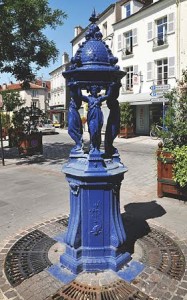Cool, Clear, Water

Just about everyone knows that throughout the centuries, clean and drinkable water in Paris was very difficult to find. Running water didn’t come to certain parts of Paris (e.g., Village of Saint-Paul) until the early 1970s. Well, one person saw to it that the citizens of Paris, in particular the poor, had potable drinking water available to them shortly after the Paris Commune of 1871.
Shortly after Napoleon’s defeat at Waterloo, a little-known charity called the British Charitable Fund (BCF) was established for the purpose of assisting British citizens who had moved to France and became destitute. In other words, they needed financial assistance for food and shelter. One of the largest benefactors (and later, a BCF trustee) was Sir Richard Wallace (1818–1890).
An Expat In Paris
Wallace was a British expat living in Paris who had inherited a large sum of money from his father in 1870. Among his other philanthropic endeavors, he founded a hospital. However, Sir Richard’s legacy to modern day Paris is the Wallace Fountain found throughout Paris (and other parts of the world).
Most of the aqueducts were destroyed during the Franco-Prussian war and the 1871 Commune. This drove up the price of water and many Parisians could not afford to purchase drinking water. In fact, the water being sold was usually non-potable as it was taken from the Seine. This drove many to drink liquor, wine, and beer. Since there was a temperance movement at the time, Sir Richard decided to personally fund the building of public drinking fountains.
These were small cast-iron sculptures (four separate designs; four different models) that formed drinking fountains and were placed in strategic spots around Paris (read: high density walking areas).
Two of the models, the large and small, are scattered today around Paris. The large models are found on the streets (sixty-seven total) while the small—push button—models (eleven total) can be seen and are used in the various parks and squares. An example of the large model can be seen in the Place Saint-Germain-des-Prés on the Left Bank. Make your way over to the Place des Invalides and you will see a small model.
The applied model was the drinking fountain installed in the sides of buildings. Only one still exists—Rue Geoffrey Saint-Hilaire. Exit the Métro Place Monge and walk north along Rue Monge until you get to Rue Lacépède. Turn right. Rue Lacépède will dead end into Rue Geoffroy-Saint Hilaire. In front of you will be a wall (behind which is the Jardin des Plantes). The drinking fountain will be on the wall in front of you.
Two Fountains Remain
The fourth model, the colonnade, was the last to be built and resembles the large model (the caryatid figures have been replaced with columns). Due to cost issues, they were smaller in dimension. Only thirty were built and today, two remain—Rue de Rémusat (at Rue de Mirabeau—16th arrondissement) and Avenue des Ternes (at Place Pierre Demours—17th arrondissement).
Much like the restored art deco signage for the entrance to certain Métro stations, the Wallace Fountains have become a treasured part of Paris and its past. Be on the lookout for them the next time you’re in Paris.
Wallace is buried in Père Lachaise cemetery in Paris. One of my future books, Where Did They Bury Jim Morrison, the Lizard King?—A Walking Tour of Paris Cemeteries, will take you to Sir Wallace’s grave site.
Do we have a lot of stories? Of course we do. I’m looking forward to sharing these with you. Please continue to visit our blog and perhaps subscribe so that you don’t miss out on the most recent blog posts.
Thanks so much for following my blog and my little journey through this incredibly interesting process of writing a series of niche historical travel books and then getting the bloody things published.
-Stew
Please note that I do not and will not take compensation from individuals or companies I mention or promote in my blog.
Are you following us on Facebook and Twitter?
Copyright © 2014 Stew Ross
